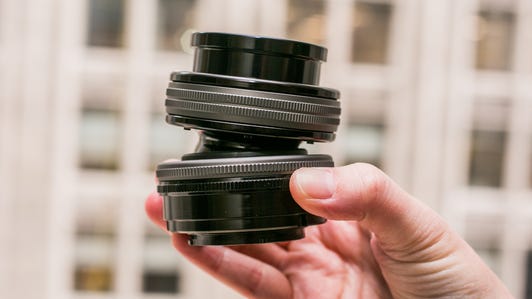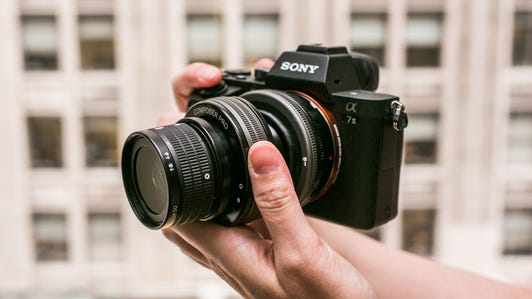 Enlarge Image
Enlarge ImageSarah Tew/CNET
Lensbaby ups its game with a higher-quality set of metal mounts and optics, toward the goal of creating a new class of lenses for creative effects that includes the Edge 80 Optic and Velvet 56 lens . The Composer Pro II improves on the original Composer Pro with a better feel and build quality, while the Edge 50 Optic brings the same “slice of focus” approach to 50mm that the Edge 80 did for 80mm.
The pair costs $425 (directly converted £275, AU$590), although if you already have a Composer, you’ll still be able to use the Edge 50 and the CP II should work with many of your older optics.
If you’re unfamiliar with Lensbaby’s Composer system, it consists of a lens mount with a section that can bend up to 15 degrees in any direction sandwiched between the mount and the focusing ring. You drop in different lenses — the Optic Swap system — to achieve different effects and focal lengths. Lensbaby offers versions for all popular mounts: Canon EF, Nikon F, Sony Alpha A and E, Pentax K, Fujifilm X, Micro Four Thirds and Samsung NX.
Lensbaby Edge 50 Optic photo samples






+10 more
For instance, the Sweet 50 optic has a “sweet spot” of focus which you can move around by bending the Composer. The Edge 50, in contrast, creates a “slice” of focus. When the focus area runs horizontally, it looks like the effect you get with a tilt-shift lens — though not as sharply as with one of those very expensive lenses –which many cameras try to simulate with the miniature effect. Rotating the Composer changes the angle of the slice.
You control the size of the focused area via the manual aperture ring; the Edge 50 supports f3.2 through f22. When the mount is straight and the lens at a middle-to-high aperture, the results look similar to a regular lens. Pulling the lens barrel forward puts you in macro focus mode — it can focus as close as 8 inches/20 cm from the front of the lens and takes 46mm screw-on filters.
Lensbaby Composer Pro II with Edge 50 Optic tilts your world (pictures)






+3 more
Lensbabies use manual focus, and it’s a lot easier to work them than it used to be thanks to the ubiquity of focus peaking (edge detection) in cameras. Still, wide open at f3.2 it’s not easy to obtain sharp focus when working closely. I frequently thought the catchlights in eyes were the peaking indicating focus and ended up with everything blurred.
But the focus ring in the CP II operates noticeably more smoothly than its predecessor, and its metal body feels much higher quality. I wish it had some way to quickly be able to set it back to perpendicular, though.
The optic is a great general-purpose focal length on a full-frame camera (I tested with the Sony A7 II ). It has a 9-blade aperture that produces smooth out-of-focus areas and round highlights.
Lensbabies are a great way to isolate a subject in a photo or video, adding another dimension of control beyond simple depth of field. Plus they’re really fun to work with. This pairing continues that tradition.




